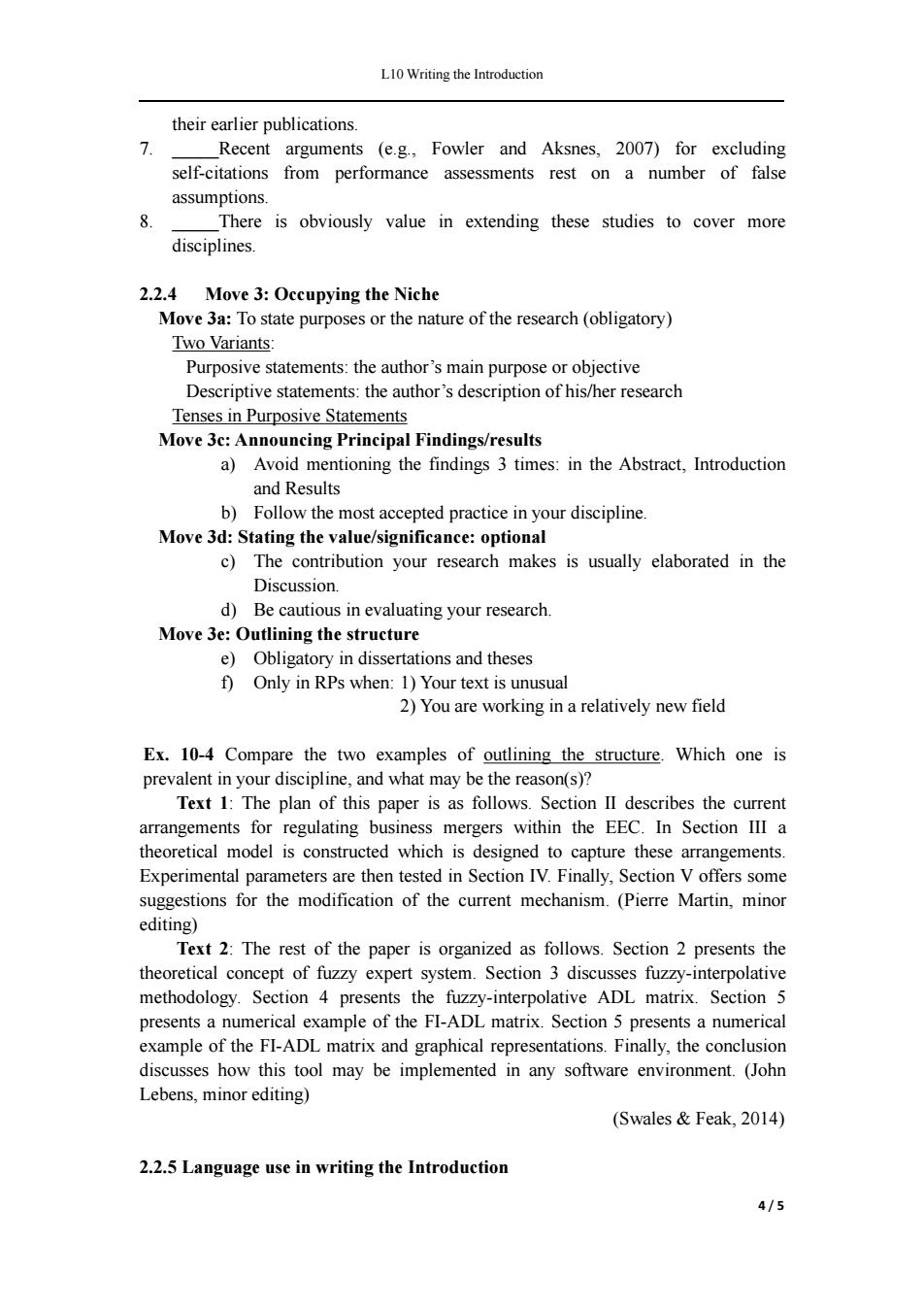正在加载图片...

L10 Writing the Introduction their earlier publications. 7. Recent arguments (e.g.,Fowler and Aksnes,2007)for excluding self-citations from performance assessments rest on a number of false assumptions. 8 There is obviously value in extending these studies to cover more disciplines. 2.2.4 Move 3:Occupying the Niche Move 3a:To state purposes or the nature of the research (obligatory) Two Variants: Purposive statements:the author's main purpose or objective Descriptive statements:the author's description of his/her research Tenses in Purposive Statements Move 3c:Announcing Principal Findings/results a)Avoid mentioning the findings 3 times:in the Abstract,Introduction and Results b)Follow the most accepted practice in your discipline Move 3d:Stating the value/significance:optional c)The contribution your research makes is usually elaborated in the Discussion. d)Be cautious in evaluating your research. Move 3e:Outlining the structure e)Obligatory in dissertations and theses f)Only in RPs when:1)Your text is unusual 2)You are working in a relatively new field Ex.10-4 Compare the two examples of outlining the structure.Which one is prevalent in your discipline,and what may be the reason(s)? Text 1:The plan of this paper is as follows.Section II describes the current arrangements for regulating business mergers within the EEC.In Section III a theoretical model is constructed which is designed to capture these arrangements. Experimental parameters are then tested in Section IV.Finally,Section V offers some suggestions for the modification of the current mechanism.(Pierre Martin,minor editing) Text 2:The rest of the paper is organized as follows.Section 2 presents the theoretical concept of fuzzy expert system.Section 3 discusses fuzzy-interpolative methodology.Section 4 presents the fuzzy-interpolative ADL matrix.Section 5 presents a numerical example of the FI-ADL matrix.Section 5 presents a numerical example of the FI-ADL matrix and graphical representations.Finally,the conclusion discusses how this tool may be implemented in any software environment.(John Lebens,minor editing) (Swales Feak,2014) 2.2.5 Language use in writing the Introduction 4/5L10 Writing the Introduction 4 / 5 their earlier publications. 7. _____Recent arguments (e.g., Fowler and Aksnes, 2007) for excluding self-citations from performance assessments rest on a number of false assumptions. 8. _____There is obviously value in extending these studies to cover more disciplines. 2.2.4 Move 3: Occupying the Niche Move 3a: To state purposes or the nature of the research (obligatory) Two Variants: Purposive statements: the author’s main purpose or objective Descriptive statements: the author’s description of his/her research Tenses in Purposive Statements Move 3c: Announcing Principal Findings/results a) Avoid mentioning the findings 3 times: in the Abstract, Introduction and Results b) Follow the most accepted practice in your discipline. Move 3d: Stating the value/significance: optional c) The contribution your research makes is usually elaborated in the Discussion. d) Be cautious in evaluating your research. Move 3e: Outlining the structure e) Obligatory in dissertations and theses f) Only in RPs when: 1) Your text is unusual 2) You are working in a relatively new field Ex. 10-4 Compare the two examples of outlining the structure. Which one is prevalent in your discipline, and what may be the reason(s)? Text 1: The plan of this paper is as follows. Section II describes the current arrangements for regulating business mergers within the EEC. In Section III a theoretical model is constructed which is designed to capture these arrangements. Experimental parameters are then tested in Section IV. Finally, Section V offers some suggestions for the modification of the current mechanism. (Pierre Martin, minor editing) Text 2: The rest of the paper is organized as follows. Section 2 presents the theoretical concept of fuzzy expert system. Section 3 discusses fuzzy-interpolative methodology. Section 4 presents the fuzzy-interpolative ADL matrix. Section 5 presents a numerical example of the FI-ADL matrix. Section 5 presents a numerical example of the FI-ADL matrix and graphical representations. Finally, the conclusion discusses how this tool may be implemented in any software environment. (John Lebens, minor editing) (Swales & Feak, 2014) 2.2.5 Language use in writing the Introduction